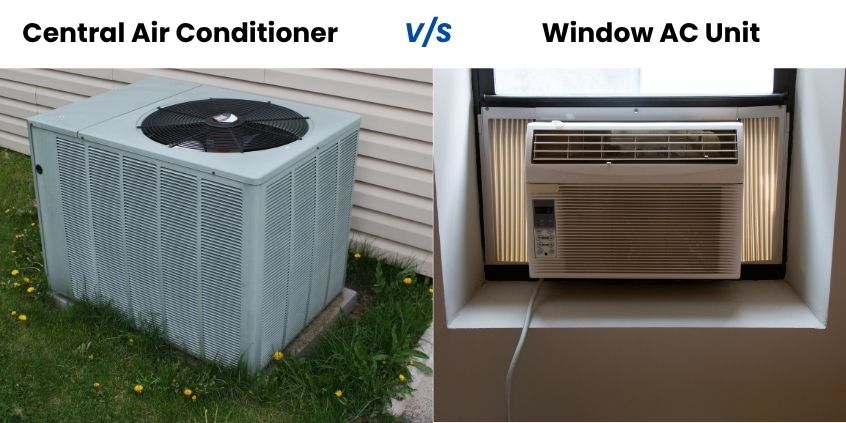Central air systems and window units both cool indoor spaces, yet they differ by scale, installation, and operating method. A Central Air Conditioner treats the entire building through ductwork, often called a whole-house AC solution.
A Window AC Unit is a compact appliance that slips into one opening and cools one or two adjacent rooms. Understanding how each works, along with their strengths and limits, helps homeowners match equipment to comfort goals and budget.
What Is a Central Air Conditioner?
A Central Air Conditioner is a split system. The whole system includes one outdoor condenser–compressor that links to an indoor evaporator coil and blower.
Cooled air travels through the air supply ducts attached to every conditioned room, which returns via separate ducts for re-cooling. As the machinery is externally situated, the interior noise stays low, and the whole dwelling receives uniform temperature control.
How Does Central AC Work?
The refrigerant is compressed, and then it is sent to the outdoor condenser for heat exchange to occur. The resulting vapor refrigerant is cooled in the indoor coil by expansion device evaporation.
The blower of the unit draws all the warm household air across this coil. During the process, it removes the heat and moisture before sending the cooled airflow into the ducts. The cycle repeats until the set temperature matches the thermostat.
Key Components of Central AC
- Compressor – raises refrigerant pressure and temperature so outdoor air can carry heat away.
- Condenser coil and fan – reject heat to the outside environment.
- Expansion device – meters refrigerant into the low-pressure side.
- Evaporator coil – absorbs indoor heat and dehumidifies.
- Air-handling unit (commonly referred to as the blower) – responsible for circulating the conditioned air throughout the entire duct system.
Advantages of Central Air Conditioners
Central systems cool every room at once, eliminating hot spots common with window appliances. Filters inside the air handler help trap dust and pollen, improving indoor air quality.
Because the condenser sits outdoors, indoor sound levels stay lower than many room units. Ducted delivery also allows occupancy-based zoning and programmable thermostats, which can trim energy use when set correctly.
Drawbacks of Central Air Conditioners
Up-front cost is higher: equipment plus professional installation and any needed duct repair often exceed $3,000 for an average home. Ducts that are either leaking or not properly insulated can lead to a loss of 20% or more of the cooled air, which in turn pushes up electricity bills significantly unless the issue is identified and properly sealed.
Structural work may be necessary in older houses that lack duct chases, adding labor and drywall repairs. Finally, a whole-house AC cools the entire dwelling even if only one room is occupied, which can increase operating expenses in mild weather.
What Is a Window AC Unit?
A Window AC Unit is a self-contained box that hangs from a window or wall sleeve. It packages the same refrigeration parts—compressor, condenser, expansion device, evaporator, and fans—into a single cabinet divided by an insulated barrier.
One side faces indoors; the other exhausts heat outdoors. Installation usually requires only a support bracket, weather stripping, and a standard electrical outlet.
How Does a Window AC Work?
The room air is drawn into the space and cooled before being circulated back into the space. Additionally, a second fan brings in outside air and passes it over the condenser coil, so that the system can discharge non-recoverable energy adequately. Condensate drips onto the rear chassis and drains outside.
Since the entire unit is sealed, the refrigerant circuit typically does not require any intervention from the homeowner, unless there is a leakage issue that arises over time.
Benefits of Window AC Units
Window models cost far less to purchase—often under US$400—and use about one-third the power of a similar-capacity central system.
They can be installed the same day without hiring an HVAC crew, making them attractive for renters or owners who only need to cool a single bedroom at night. Seasonal removal restores the window for fresh air during cooler months.
Drawbacks of Window AC Units
Noise is the top complaint; compressors and fans share the living space and can exceed 50 dB, disrupting sleep or conversation.
Units block daylight, and the window itself becomes a potential security weak point. Cooling is limited to the immediate zone, so multiple devices may be required for larger dwellings, eroding initial savings and increasing wattage.
Comparison at a Glance
| Feature | Central Air Conditioner | Window AC Unit |
| Coverage | Whole house AC through ducts | Single room or small zone |
| Energy Use (average) | ≈ 3,000 W per hour for a mid-size home | ≈ 1,000 W per hour for a 10 k BTU unit |
| Noise Indoors | Low (outdoor compressor) | Moderate to high |
| Air Quality Features | Integrated filter, optional dehumidification | Basic washable screen |
| Installation | Requires pro labor and duct network | DIY is possible, with minimal tools |
| Aesthetic Impact | Equipment largely hidden | Occupies the window opening |
| Security Impact | None | The window opening may be vulnerable |
| Maintenance | Annual filter change, periodic duct checks | Seasonal cleaning and storage |
| Best Use Case | Year-round comfort for large dwellings | Budget cooling for targeted spaces |
Conclusion
A Central Air Conditioner is ideal for homeowners seeking consistent, whole-home cooling and are comfortable with a higher upfront investment for long-term comfort and efficiency. On the other hand, a Window AC Unit is perfect for cooling individual rooms and offers quick, cost-effective installation. Carefully considering your home’s size, energy needs, and budget will help you make the right choice. For expert guidance and reliable installation, trust All About Air Conditioning & Heating LLC to help you find the perfect solution for your comfort.


